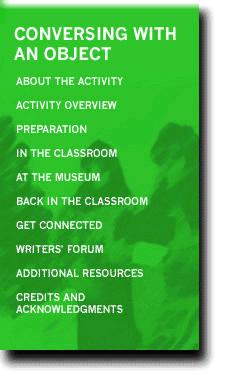

In the Classroom
![]() Review the conventions for writing dialogue.
Review the conventions for writing dialogue.
Discuss the concept of dialogue with the students, pointing out that written
dialogue is a conversation on paper. Go over the use of quotation marks
and rules for indentation. (You may want to give students the option of
writing their dialogues in interview style. If so, bring in samples of magazine
interviews and review this style as well.)
![]() Have students choose objects to write about.
Have students choose objects to write about.
Explain that each student will be writing a dialogue between two of the
objects on display. Give them a few minutes to think about which objects
might have an interesting conversation if they could speak to one another.
Tell students that the objects they choose can be related in some way (such
as a bottle of soda and a glass) but don't necessarily have to be.
![]() Give students twenty or thirty minutes to write their dialogues.
Give students twenty or thirty minutes to write their dialogues.
To help them get started, suggest some topics that their objects might talk
about. For example, objects could compare their functions, discuss where
they live (e.g., in the pantry, in the refrigerator, in a student's desk)
and describe what a typical day in their lives is like. You might also want
to suggest to students that they give their objects personalities or certain
characteristics. For example, a cactus could have a "prickly"
personality, and a dictionary could have an excellent vocabulary.
![]() Have students read or perform several of the dialogues.
Have students read or perform several of the dialogues.
Collect the students' work. If possible, select several pieces that offer
clues to the objects' identities without giving them away. (If you can't
find any, select some that the writers could modify slightly to achieve
"anonymity.") Have the writer of each piece, along with one other
student, read or perform the conversation. Ask the group if they can say
which objects are having the discussion.

